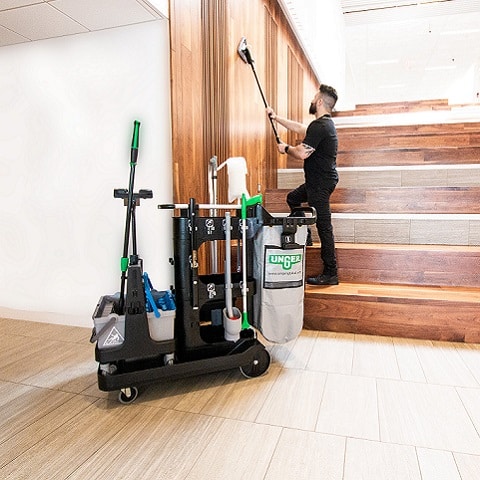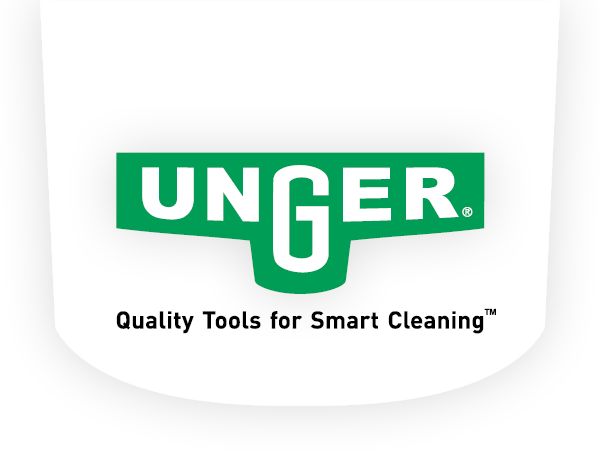NEW! Powerful Nano Filtration with Unger's HydroPower® Nano See The Product

What Features Should You Look for in Janitorial Carts?
When it comes to choosing between janitorial carts, there are plenty of options to consider, from compact models designed for tighter spaces like convenience stores, to larger carts built for expansive facilities such as schools, corporate offices and hotels. Each type comes with its own unique features, and the choices can feel overwhelming.
That’s why it helps to focus on what truly matters: cleaning smarter, faster, and safer. With those priorities in mind, three features stand out as the most important to evaluate to ensure that your janitorial cart isn’t just another piece of equipment:
- Storage Compartments and Tool Organizers
The best janitorial carts include built-in storage areas that keep supplies organized. Look for shelves, compartments, and tool holders where staff can safely store brooms and mops, and also easily access frequently used items such as sprays and microfiber cloths. Having a place for everything saves time, prevents lost items, and keeps cleaning routes more efficient.
- Mop Bucket and Wringer Integration
A cart featuring space for a dual-compartment mop bucket with wringer makes floor care easier by reducing unnecessary trips back to the supply closet. Additional features such as a drip tray keeps water off the floor while the cart is moving between areas and improves mop bucket stability.
- Customizability with Add-Ons
Not every facility has the same cleaning needs, so it’s smart to invest in customizable carts. With flexible cart options, you can have a cart designed for specific cleaning tasks, with tool clips, shelves, and add-ons for deep cleaning, spot cleaning, or zone-based maintenance.
- Build Quality
Not all carts are designed and built to the same level of quality. Choosing a cart with high durability will ensure many years of use. Ergonomic and well-built handles will create stability and provide more comfort to the user. Higher quality wheel casters will prevent markings on the floor and provide quiet operations in areas where squeaky wheels have no place.
How Easy Is It to Move a Janitorial Cart Around?

Swivel casters allow the cart to rotate smoothly, which helps staff navigate hallways, doorways, and narrow aisles without straining.
A janitorial cart should make cleaning easier, not harder, which means you have to consider how smoothly it moves through your facility. The design of the wheels, casters, and overall maneuverability all play a role in keeping your staff efficient and safe.
Economy carts, while more affordable, often come with smaller wheels or lower-quality casters that can snag on thresholds, carpets, or uneven floors. They may also lack swivel casters or proper weight distribution, making tight turns more difficult and requiring more effort to push or pull.
- Importance of Swivel Casters and Wheel Size
Swivel casters allow the cart to rotate smoothly, which helps staff navigate hallways, doorways, and narrow aisles without straining. Wheel size also matters: larger wheels can roll more easily over uneven surfaces, thresholds, and longer distances, while smaller casters work well for light-duty carts in compact areas.
- Maneuverability in Tight Spaces
A well-designed cleaning cart should turn easily and fit through narrow spaces. A cart with 360-degree swivel casters, a balanced design, and rounded corners enables custodial teams to operate around tight corners, move through crowded hallways, and avoid bumping into walls or doorframes, protecting both the cart and the property.
How Big Should a Janitorial Cart Be?
Cart size depends on your facility’s layout and your cleaning needs. If a cart is too large, it may be difficult to store or maneuver. If the cart is too small, it won’t hold everything your staff needs to complete tasks efficiently (or potentially, safely).
- Assessing Storage Space vs. Mobility
Facility managers need to balance storage requirements with maneuverability. The goal is to carry all necessary cleaning supplies without creating a cart that’s too heavy to push. While the Occupational Safety and Health Administration (OSHA) does not set a specific weight limit for janitorial carts, it emphasizes the importance of evaluating the risk of injury associated with pushing, pulling, and handling the weight of a fully loaded cart and implementing measures to prevent musculoskeletal disorders. - Measuring Your Spaces
If there is one mandatory requirement to check before buying a cleaning cart, it’s to measure storage and access points. Janitorial carts spend a lot of time moving through tight spaces, such as supply closets, elevators, and narrow hallways, so before purchasing, measure these areas to make sure the cart can easily fit through. - Compact Options for Small Facilities
Convenience stores and small offices, for example, may not require a large cart. Instead, a compact janitorial cart offers easy storage and maneuverability while still offering enough compartments for basic supplies.- Compact cart scenario:
In a WeWork office environment, custodial staff may need to move carts through long hallways, across different flooring types, and into shared spaces with tight layouts. A poorly maneuverable cart in this setting can slow down cleaning. - Full-size cart scenarios:
A university facility manager selects a larger cart with multiple shelves, a mop bucket, and add-ons for waste collection. This setup allows custodial staff to cover more ground in one trip, reducing back-and-forth trips to the supply closet.In a hotel, maintaining lobbies, restrooms, banquet areas, and other high-traffic common spaces requires a cart that can handle a wide range of cleaning tasks. A full-size janitorial cart equipped with shelves for supplies, compartments for cleaning solutions, and attachments for mop buckets and waste collection allows custodial staff to clean restrooms, floors, and more in one efficient sweep. Because these areas often see continuous guest activity, having everything on hand minimizes downtime and avoids repeated trips to supply closets.
- Compact cart scenario:
What Materials Are Best for Durability and Cleaning?
The right construction ensures that the cart can handle daily wear-and-tear and stand up to cleaning chemicals over years of use.
- Plastic vs. Metal Carts
Plastic carts are lightweight and resistant to rust, while metal carts are sturdier but heavier. Plastic carts are also generally quieter when rolled across floors. - Chemical Resistance
Janitorial carts can be exposed to harsh disinfectants, floor cleaners, and other chemical agents. High-quality plastic carts typically resist chemical damage better than untreated metal. - Ease of Wiping Down
Since carts often move between restroom cleaning, classrooms, and public spaces, they should be sanitized frequently to help prevent cross-contamination. Plastic carts usually have smooth surfaces that you can quickly wipe down, while metal carts may have seams or textures that trap dirt.
What Type of Janitorial Cart is Right for My Industry?
The best janitorial cart for your facility depends on your environment, cleaning routines, and the way your team works, for example, if you practice zone vs. team cleaning. Here are some examples to guide your choice:
Schools and Campuses: Lightweight, versatile carts work best for schools. Custodial teams in schools often clean large areas and need to move quickly between classrooms, gyms, and hallways. For zone-based cleaning, larger carts are helpful so staff can cover an entire area without returning to the supply closet.
Office Buildings & Hospitality: In these buildings, cleaning staff often manage multiple spaces, including conference rooms, common areas, restrooms, and breakroom cleaning. Carts with organized storage, compartments for all necessary tools, and a professional appearance work best. Carts should be quiet and easy to maneuver, while still offering enough capacity to cover multiple areas in one trip.
Convenience Stores and Small Retail: Compact carts with essential storage compartments are easier to maneuver through narrow aisles without blocking customers. These are ideal for spot cleaning and quick touch-ups, often handled by one person rather than a team.

How Much Do Janitorial Carts Cost?
When purchasing any type of commercial cleaning product, we encourage you to balance price with quality considerations. While you could always select the cheapest option, remember that a higher investment typically reflects durable construction, dependable wheels, and innovative design that enable your team to clean smarter, faster and safer.
Materials, features, and brand reputation have the biggest impact on cost:
- Plastic carts are often more affordable and lightweight, while metal carts may cost more but offer added strength.
- Integrated mop systems, tool clips, and ergonomic designs may add to the price but improve long-term efficiency and safety.
- While less expensive carts may initially seem attractive, they often wear out faster, have poor-quality wheels, or lack organizational features, leading to replacement part costs and cleaning inefficiency. More expensive carts have a larger upfront investment, but are more dependable in terms of rolling smoothly, reducing wasted time, and delivering lower overall costs in the long run.
More than a Tool, It’s Your Partner
Choosing the right janitorial cart isn’t just about buying equipment, it’s about investing in the efficiency, safety, and organization of your cleaning team. By focusing on the features that matter most, facility managers can ensure staff work smarter, faster, and with fewer risks. The right cart becomes more than just a tool; it becomes a partner in maintaining a cleaner, safer, and more productive environment.

